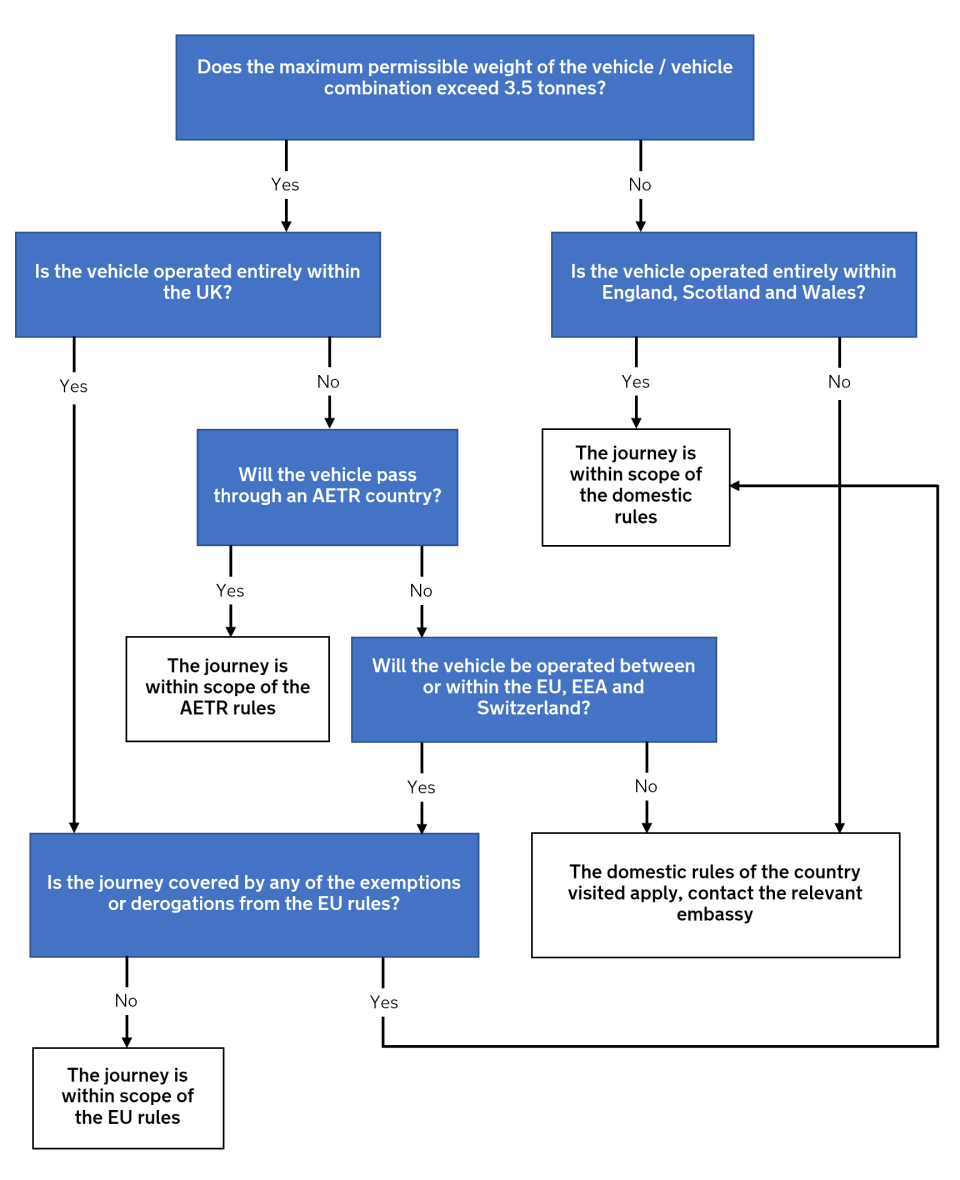Introduction
Overview of which drivers' hours and tachograph rules apply in different situations for vehicles used for the carriage of goods.
This guide provides advice to drivers and operators of goods vehicles, whether used privately or commercially. It explains the rules for drivers’ hours and the keeping of records.
In this guide, any reference to ‘assimilated rules’ means Regulation (EC) 561/2006 and Regulation (EU) 165/2014, as they have effect in the UK. Any reference to ‘AETR rules’ means the rules under the European Agreement Concerning the Work of Crews of Vehicles Engaged in International Road Transport.
Following the UK’s departure from the EU, national journeys within the UK must follow assimilated drivers’ hours and tachograph rules. Assimilated rules also apply to international journeys between the UK and EU.
The assimilated and AETR rules (see annex 1)also place a responsibility on others in the supply chain such as consignors, freight forwarders, contractors, sub-contractors and driver agencies. People working in these sectors of the road haulage industry may benefit from an understanding of the guidance offered here.
Those who are involved in international operations are advised to check whether the other country or countries in which they operate produce equivalent guidance. We recommend that you contact the relevant embassy.
As with any legislation, previous and future court judgments may assist interpretation on a particular point. Where significant court judgments on interpretation are relevant, these have been incorporated in the text. Some important judgments are available – many in shortened form – in legal reference books held by larger reference libraries. If you are in doubt as to how these rules apply to you, seek your own legal advice.
The set of rules that applies depends on:
- the type of driving
- the type of vehicle being used
- the countries visited
Within Great Britain (GB), either GB domestic or assimilated rules may apply.
For international journeys, either assimilated rules or AETR rules may apply.
Most vehicles used for the carriage of goods by road and with a maximum permissible weight (including any trailer or semi-trailer) of over 3.5 tonnes are in scope of the assimilated rules; unless covered by an exemption or a UK national derogation. Exemptions apply to both UK national journeys and journeys between the UK and EU.
AETR rules apply to international journeys that are not wholly between the UK and the EU and are from, to or through a country that is a signatory to AETR.
Carriage by road ‘Carriage by road’ is defined as any journey, made entirely or in part on roads open to the public, of a vehicle, laden or unladen, used for the carriage of passengers or goods. ‘Off-road’ driving is in scope of the rules, where it forms part of a journey that also takes place on public roads. Journeys that are made entirely off road are out of scope of assimilated drivers’ hours rules and tachograph rules. However, under assimilated and AETR rules on record keeping, drivers who carry out any work regulated under these rules must record all periods of off-road driving as ‘other work’.
Goods
For the purposes of drivers’ hours rules, the term ‘goods’ includes goods or burden of any description. It does not include parts of a vehicle or trailer’s fixed equipment manufactured as part of the vehicle or trailer, and which enables the extension of fixed equipment. It also does not include ballast used for the purpose of road testing a vehicle or trailer, or for MOT or annual test purposes provided the ballast is a non-commercial load.
Non-commercial carriage is defined as any carriage by road, other than carriage for hire or reward or on own account, for which no direct or indirect remuneration is received and which does not directly or indirectly generate any income for the driver of the vehicle or for others and which is not linked to professional or commercial activity.
A trailer (including anything permanently attached to it) is not ‘goods’ unless it is being wholly carried on a vehicle or another trailer.
International journey An international journey means a journey to or from the UK and includes the part of the journey within the UK.
Countries outside the EU and AETR are likely to have their own regulations governing drivers’ hours, which should be adhered to while driving in that country.
Most vehicles that are exempt from assimilated rules come under GB domestic drivers’ hours rules while engaged on domestic journeys.
This flowchart will help determine which rules apply in connection with goods vehicles.

EU countries
- Austria
- Belgium
- Bulgaria
- Croatia
- Cyprus
- Czech Republic
- Denmark
- Estonia
- Finland
- France
- Germany
- Greece
- Hungary
- Ireland
- Italy
- Latvia
- Lithuania
- Luxembourg
- Malta
- Netherlands
- Poland
- Portugal
- Romania
- Slovakia
- Slovenia
- Spain
- Sweden
Reminder: Switzerland is not a member of the European Union but follows the drivers’ hours rules in Regulation (EC) 561/2006 when on EU territory. Drivers must follow AETR rules when on Swiss territory.
AETR countries
All EU countries plus:
- Albania
- Andorra
- Armenia
- Azerbaijan
- Belarus
- Bosnia and Herzegovina
- Georgia
- Kazakhstan
- Liechtenstein (EEA country)
- Macedonia
- Moldova
- Monaco
- Montenegro
- Norway (EEA country)
- Russia
- San Marino
- Serbia
- Switzerland
- Tajikistan
- Turkey
- Turkmenistan
- United Kingdom
- Ukraine
- Uzbekistan
Journeys between the UK and Liechtenstein or Norway must follow AETR rules.
Journeys between the UK and Iceland must follow AETR rules. On Icelandic territory, Icelandic national rules apply to that portion of the journey.